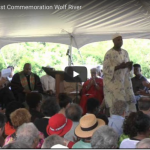by John Ashworth
In 1917, James Weldon Johnson, best known as the author of "Lift Every Voice and Sing," visited the site where Ell Persons was burned to death beside the Wolf River, just outside Memphis.
While viewing the residue of the burned body, Johnson remarked that "the truth flashed over me that in large measure the race question involves the saving of black America’s body and white America’s soul."
This week in Montgomery, Ala., Persons and thousands of other lynching victims will be memorialized at the opening of the National Memorial for Peace and Justice and the Legacy Museum.
It is to be a site where people can gather and reflect on our history of racial inequality -- including slavery, racial terror, segregation, mass incarceration.
Americans take great pride in the wealth of our nation, without giving much thought to the foundations of that wealth. Our country’s economic power was built on the backs of people brought and kept here against their will and enslaved for nearly 250 years.
A brutal four-year war, resulting in the deaths of over 600,000 countrymen, was waged to maintain access to that labor and wealth. That effort having failed, a period of unrestrained terror ensued against the descendants of enslaved people.
The new memorial, established by the Equal Justice Initiative, commemorates those atrocities and their brutalized victims. EJI researchers have identified the extra-judicial deaths (lynchings) of more than 4,000 U.S. citizens between 1877 and 1950, including more than 30 in Shelby County.
The memorial consists of hanging columns arranged by counties, each column containing the names of people lynched in their respective county. Lynching victims have been identified in 800 of the more than 3,000 U.S. counties.
Duplicate columns are being made available for each county’s retrieval. Communities across the country have begun the very difficult process of acknowledging the part they played in the injustice and violence of our nation’s past.
In 2015 a group of concerned local citizens, inspired by a presentation by EJI founder Bryan Stevenson, formed the nonprofit Lynching Sites Project of Memphis (LSP).
LSP's mission is to identify all Shelby County lynchings and install historical makers at those lynching sites. We seek to learn as much as possible about each lynching, so we can create records that are more historically accurate.
By collecting soil from lynching sites through EJI’s Community Remembrance Project, we at LSP are also part of a campaign to recognize and honor victims and their families through a tangible, humbling experience.
Our work has resulted in reuniting family members with their ancestral heritage and knowledge. On May 20, members of the Ell Persons family will journey to Memphis for a small candlelight vigil on the 101st anniversary of his lynching.
LSP has worked with groups and communities across our community. Students from Overton and Central high schools have voluntarily participated in and confronted the history of lynching in their community. Local musicians, visual artists, and actors have used their talents to explore lynchings and their legacy.
LSP relishes and relies heavily on forming and strengthening partnerships with other Memphis organizations to open and deepen the conversation about race.
This conversation, we believe, is essential to our shared future and the ultimate uniting of this, our beloved community.
John Ashworth is executive director of the Lynching Sites Project of Memphis.








































